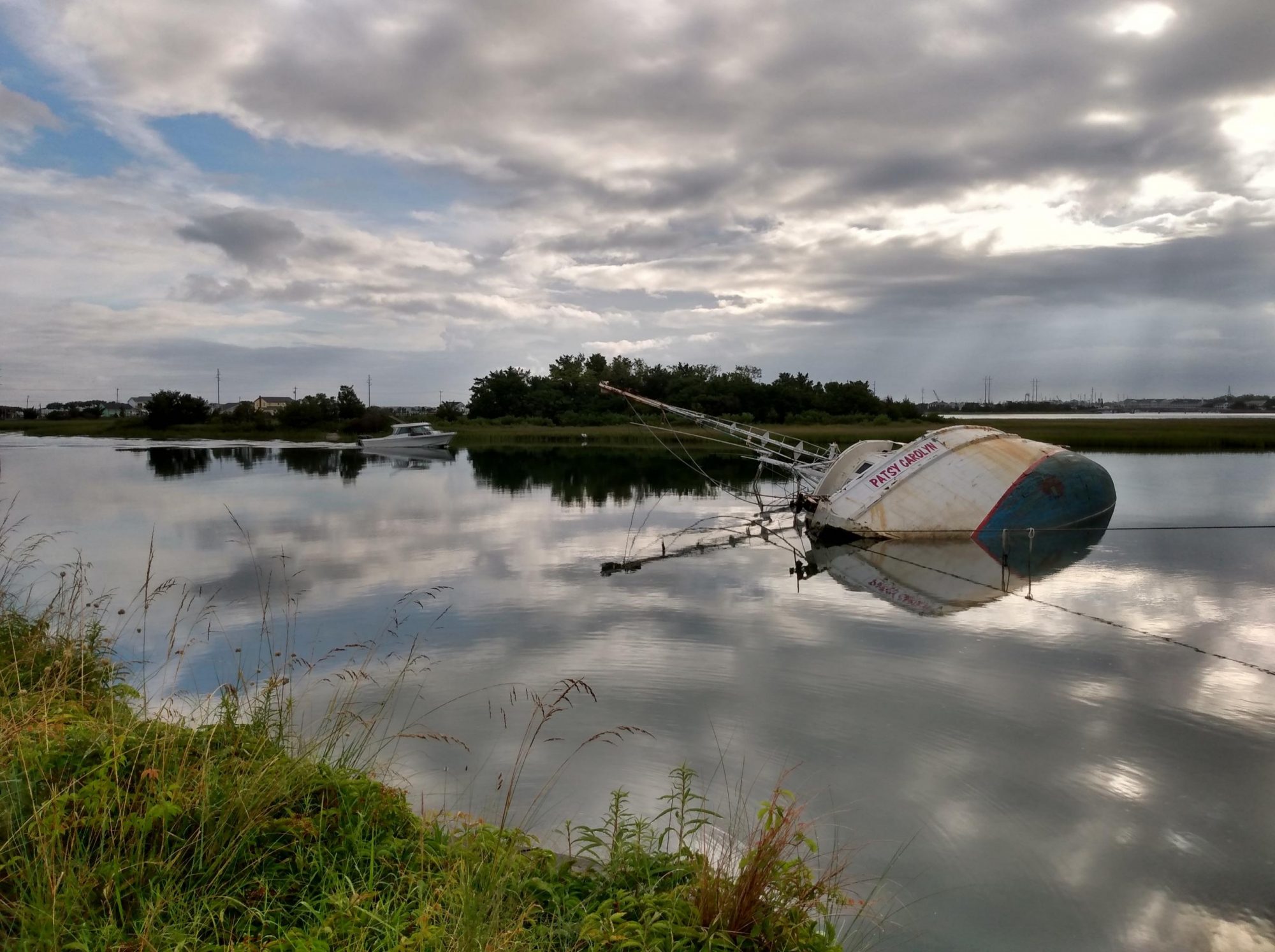Marine debris results from storm-damaged docks, houses, and yards; lost fishing gear; poorly managed construction sites; abandoned boats; plastics contained in wastewater and stormwater discharges; and careless littering.
The Coastal Federation partnered with community groups, academia, and government agencies in 2020 to develop and adopt the N.C. Marine Debris Action Plan to both clean up and prevent debris large and small.
The Coastal Federation will work for the reduced use of single-use plastics, advocate for more storm-resilient building and maintenance practices for docks and piers, and promote improved treatment and disposal of wastewater and stormwater to reduce the number of microplastics being discharged to coastal waters.
We also partner with state and local partners to continue to mobilize fishers and contractors to remove tons of debris, lost crab pots, and abandoned vessels. This work is supported with a $500,000 appropriation from N.C. General Assembly. Since 2019 the Federation and its partners have removed 4,045,519 pounds of debris.
We also continue to partner with federal, state, and local agencies to refine programs to reduce the number of abandoned boats and debris along our coast and conduct extensive education and outreach about the importance of marine debris prevention and improved understanding through research.
Tons of marine debris collected since 2019:
tons in Carteret County
tons in Onslow County
tons in Brunswick County
tons in New Hanover County
tons in Pender County
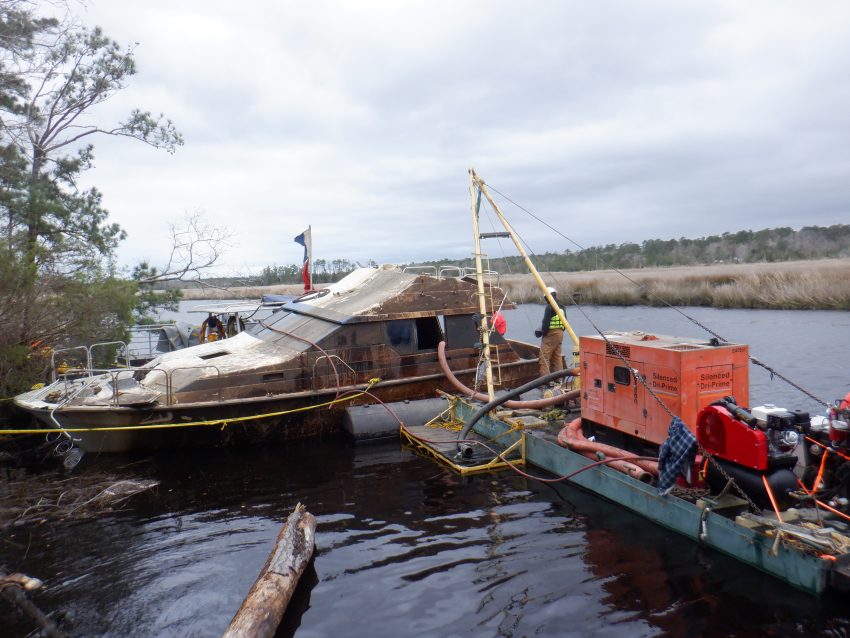
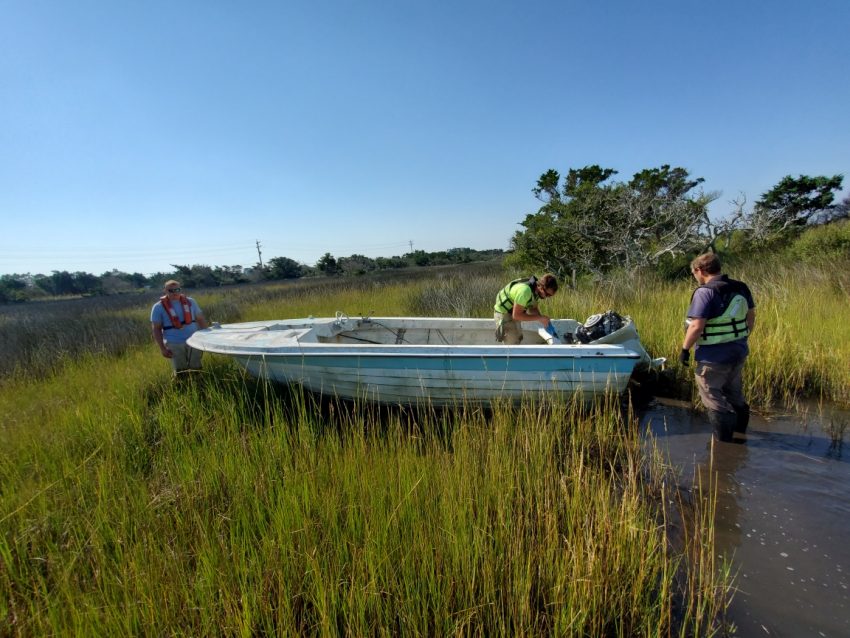
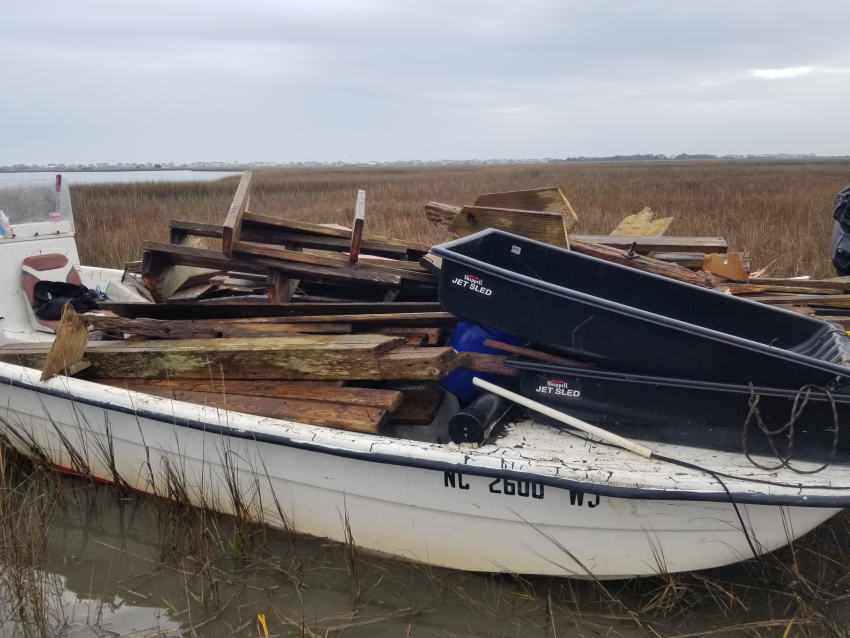
Large-Scale Debris Cleanup
In the wake of several devastating hurricanes, stakeholders developing the Marine Debris Action Plan for North Carolina began focusing on the significant number of abandoned and derelict vessels (ADVs) and large-scale marine debris deposited by the storms in our estuaries, islands, and wetlands. The debris is made up of materials from docks, piers, houses, and other coastal structures, including pressure-treated and creosote lumber, plastic and polystyrene floats, building materials, household trash, and lost fishing gear. The need for large-scale, coordinated cleanups became very apparent, launching the first clean-up project in 2019.
Projects
Marine Debris Removal in the Central and Southeast Regions
In 2020, the Coastal Federation partnered with the Division of Coastal Management (DCM) to continue the large-scale hurricane marine debris cleanup from Carteret to Brunswick County. The U.S.D.A and the Natural Resource Conservation Service’s (NRCS) Emergency Watershed Program provided nearly $1.9 million in funding that was matched by about $500,000 from state appropriations to the Division to clean up marine debris from Hurricane Florence. This funding also addressed abandoned and derelict vessels that were littering the coast. The project focused on cleaning up debris from the public trust waters, lands, and dredge spoil islands in and around the Rachel Carson Reserve, Hammocks Beach State Park, Permuda Island, and Masonboro Island Reserves, their respective counties, and Brunswick County.
Since field crews began removing debris in the central and southern region in July 2020, a total of 656.23 tons (1,312,460 pounds) of debris has been removed so far (4/20/2023) under this project. That weight is equivalent to more than 4 blue whales!
Additionally, the Federation received a grant from the National Fish and Wildlife Foundation of $1.3 million in 2020 to clean up marine debris and abandoned and derelict vessels from Hurricane Michael and Florence along the southern and central coasts. A total of 319.47 tons of debris has been removed.
In 2022, The Coastal Federation received $500,000 from the N.C. General Assembly to remove marine debris from the coast of North Carolina. This funding supported the Lost Fishing Gear Recovery Project in 2022, general hurricane marine debris removal efforts as well as abandoned and derelict vessel removals. A total of 130.77 tons have been removed thus far.
More than 30 commercial fishermen and women, working in crews of 3-4 people with small skiffs have been scouring the coast for lumber, floats, polystyrene, piling, and other debris from waterfront structures. The debris is collected by hand and loaded into dumpsters for disposal. Each crew picks up an average of 2,000 pounds (1 ton) of debris each day. Household debris and consumer trash only make up about 10-15% of the debris that is being found.
Donovan Smith, supervisor for the central region crew shared, “I couldn’t believe how much debris is out here. It would be great if we could clean up all down the coastline. I’m a commercial fisherman on the side, so it’s important to me to keep the water clean. All the debris, trash, and pollution are not good for wildlife, fish, and oysters. It’s not good for anything.”
“People should really pay attention to how these things are being built and maintained along the coast. It probably would be cheaper for the property owner and the public to build these more solid than to replace them with every storm”, said southeast field crew leader Joe Huie.
Added to the tons of debris are the many Abandoned and Derelict vessels (ADVs) that were scattered all along the coast during hurricanes and tropical storms Mathew, Florence, and Michael. Vessel removals began in March 2021 and are focused on the ADVs from hurricanes Florence and Matthew. Moran Environmental Recovery Commercial Diving Division is contracted for these removals along with several local sub-contractors and local crews of fishermen.
NOAA Marine Debris Program in the Southeast Region
The National Oceanographic Atmospheric Administration (NOAA) Marine Debris Program is supporting the Federation’s work with marine contractors and local municipalities to create model building codes and construction specifications to ensure docks and piers are built stronger to better withstand the forces of future hurricanes. For future preparedness, the Federation is also working with NOAA to develop best management practices and a case study on large-scale marine debris removal for distribution by NOAA for other regions. This funding also supported additional debris removal from Pender, New Hanover, and Brunswick Counties. A four-person crew of fishers from Sneads Ferry collected 115 tons of debris from Topsail Sound and Middle Sound between November 2019 and May 2020. An additional 1,000 lbs. of debris was collected by volunteers during clean-up events at the Morris Landing Clean Water Preserve on Stump Sound.
Click here to read more about the project from the crew’s perspective.
NC General Assembly Funding for Marine Debris Cleanup in Central and Southeast Regions
In 2019 the North Carolina General Assembly provided $400,000 in funding to the NC Department of Environmental Quality to remove Hurricane Florence debris in Carteret and Onslow Counties. The project focused on consumer debris and heavy wooden debris from damaged docks and piers that had washed up after Florence. During 6 months, crews of fishermen and women, and locals worked tirelessly by hand and using small boats to clean up 43 miles of marsh and dredge spoil islands along the Intracoastal Waterway near Swansboro, the lower New River, and Stump Sound. Over 200 tons of consumer and wooden debris from Hurricane Florence was picked up, along with three abandoned and derelict vessels. To maintain habitat quality and not cause disturbance to the surrounding marsh vegetation, the crew members hauled out wood by hand to piles that the contractor could reach with heavy equipment from the waterway.
Abandoned and Derelict Vessels
N.C. Wildlife Resource Commission Empowered and Funded to Take Action on ADVs
The N.C. Wildlife Resources Commission (WRC) was appropriated $1 million from the North Carolina General Assembly in 2021 and $1.5 million in 2022 to address and remove abandoned and derelict vessels across the North Carolina coast. In partnership with the Division of Coastal Management and the Federation, a full-scale collaborative effort was conducted to address the removal of these vessels. The Federation is partnering with WRC to engage legislative staff and members in promoting a permanent abandoned and derelict vessel program. Legislative language was passed in early July 2020 allowing WRC the authority to inspect, investigate, and remove abandoned and derelict vessels under Section 2.1 of S.L 2019-224. Vessels that have been identified as abandoned or derelict are maintained on a state database and prioritized for removal. WRC maintains a map of ADVs and provides an email to report ADVs: adv@ncwildlife.org.
With funding from state appropriations, WRC has removed around 200 vessels since 2021.
Projects
N.C. General Assembly State Appropriation
The Coastal Federation received $500,000 from the N.C. General Assembly to remove marine debris from the coast of North Carolina in 2022. This funding supported the Lost Fishing Gear Recovery Project in 2022, general hurricane marine debris removal efforts as well as abandoned and derelict vessel removals. As of September 2024, 11 vessels have been removed. A total of 161.37 tons of marine debris have been removed. A total of 1,983 derelict crab pots were removed in 2022.
Natural Resources Conservation Service
The Coastal Federation has partnered with the Division of Coastal Management in 2020 to secure over $2 million to expand previous hurricane debris cleanup efforts and address the removal of abandoned and derelict vessels in coastal waters. The Division of Coastal Management received funding from the Emergency Watershed Program run by the Natural Resources Conservation Service (NRCS). This federal funding was matched with an additional $250,000 appropriated by the N.C. General Assembly to the Division. Vessel removals began in the central and southeast coast of N.C. in late March 2021. As of November 1, 2022, all 24 of the targeted vessels have been removed.
National Fish and Wildlife Foundation
The Federation received a grant from the National Fish and Wildlife Foundation of $1.3 million in 2020 to clean up marine debris and abandoned and derelict vessels from Hurricane Michael and Florence along the southern and central coasts. Under this grant, 53 vessels were removed from March 2021 to April 2023 from Brunswick, New Hanover, Pender, Onslow, Carteret, Craven, Pamlico, and Beaufort counties. A total of 319.47 tons of marine debris were removed from the central and southeast coasts.
NOAA Marine Debris Program Vessel Removal in the Northeast Region
The Coastal Federation removed large-scale marine debris in the Albemarle-Pamlico Sound with a grant award from the National Ocean and Atmospheric Administration’s (NOAA) Marine Debris Program. Division of Coastal Management staff identified numerous abandoned and derelict vessels and other large-scale marine debris that negatively impacted different habitats within Currituck Banks and Kitty Hawk Woods component of the N.C. Coastal Reserve. The Federation coordinated the project in partnership with Dare County and the Division of Coastal Management. Vessel removals began in the fall of 2021 in the northeast region. A total of 23 vessels were removed by January 2022.
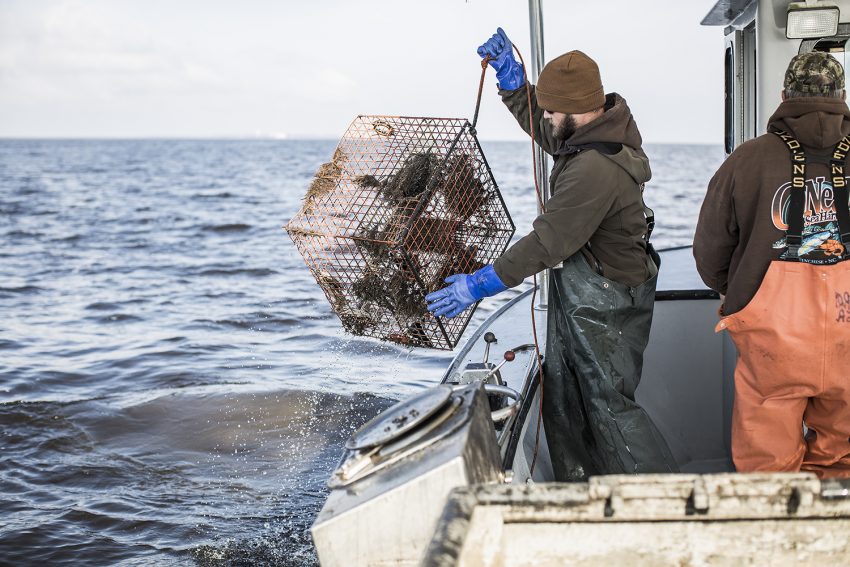
Lost Fishing Gear Recovery
Every year, crab pots and other fishing gear are lost in our sounds. The Federation and local partners work to remove these pots, which are hazardous to boats and marine life. Since 2014, the Federation has led the Lost Fishing Gear Recovery Project to remove more than 20,000 lost crab pots from North Carolina sounds.
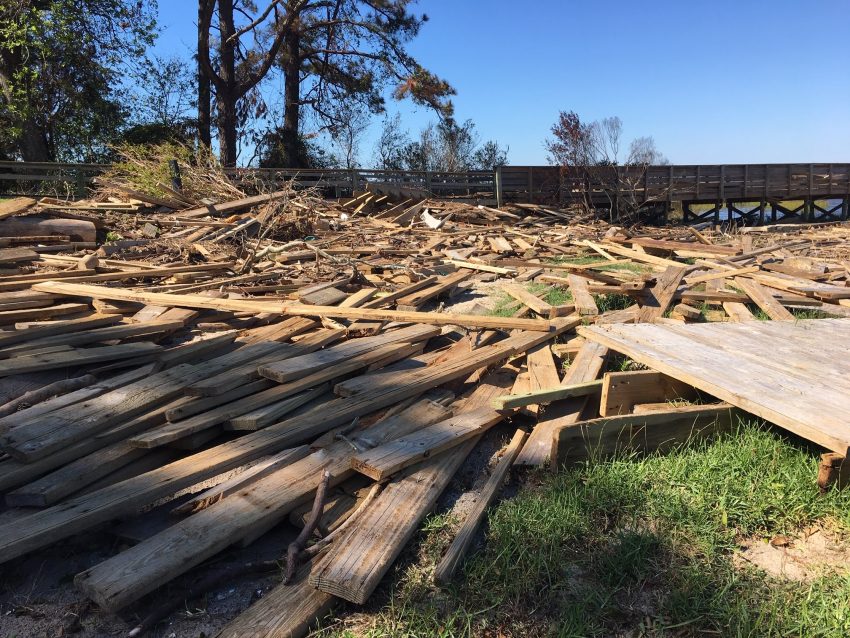
Resilient Docks & Piers
Over 85% of the debris removed from North Carolina’s estuaries between 2019-2022 was the result of damaged and/or lost docks, piers, boat houses, and similar structures. New standards for the design and construction of residential docks and piers have been developed to help reduce damage, losses, and marine debris.
Microplastics
Microplastics pose many risks to both humans and wildlife. Because of their small size, many animals mistake microplastics for food. From the tiniest zooplankton to the largest of whales, microplastics have been found in virtually every known marine organism. Even oysters and other shellfish have been found to contain microplastics. Microplastics have been found in waterways, soils, foods, and even in the atmosphere.
In addition to physical threats, chemicals, and toxic materials can attach to microplastic particles, furthering the risk to our environment, wildlife, and public health.
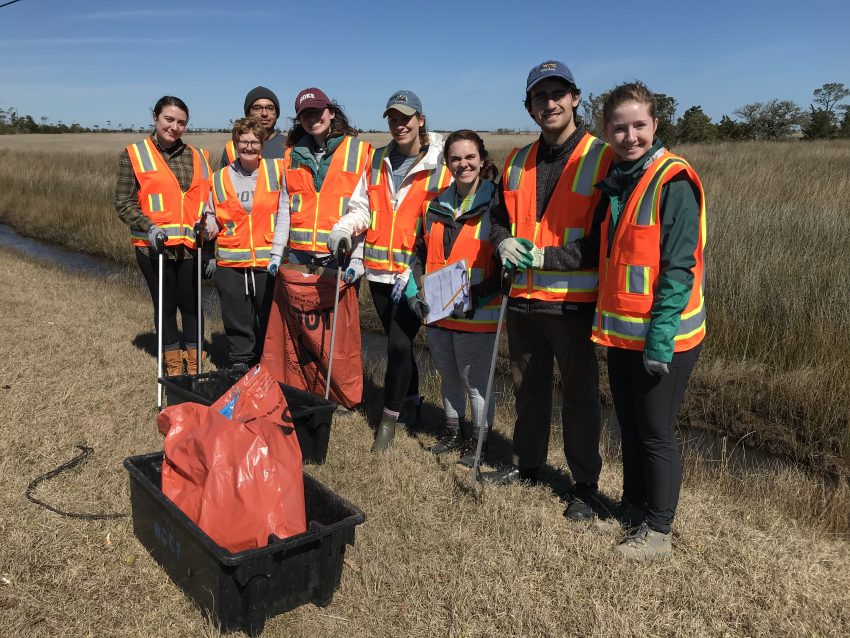
Coastal Cleanups
The Coastal Federation works with local volunteers to collect and remove marine debris throughout the coast. This helps protect local wildlife, salt marshes, and marine life. Every year, we host community organizations, volunteers, and school and college groups from around the country to help keep the North Carolina coast safe and beautiful.
Along our coast, litter is dangerous to wildlife that mistake it for food or become entangled in trash items. It is also a hazard to humans and hurts our economy.
Participate in a Cleanup
One way to help reduce marine debris is to participate in a prescheduled local cleanup or organize your own cleanup with the help of our checklist. You and your family can remove litter in your yard, a nearby park, or a local shoreline! With the Marine Debris Tracker App, you can collect data to share with researchers. This citizen science data can be used to influence decisions on policy, draw scientific conclusions, or be used in other research. We appreciate your help collecting as much data as possible! Tag us in your cleanup photos so we can thank you for your help. Follow along with other marine debris activities along the coast @DebrisFreeNC.
Federation-led cleanups continue throughout the year and are focused on maintaining our project sites and properties, such as our living shorelines and conservation easements. Cleanup partners and locations may vary based on site conditions and the amount of debris. Stay updated at nccoast.org/events for cleanups in your region!
Marine Debris Resources


Resources from around the web:
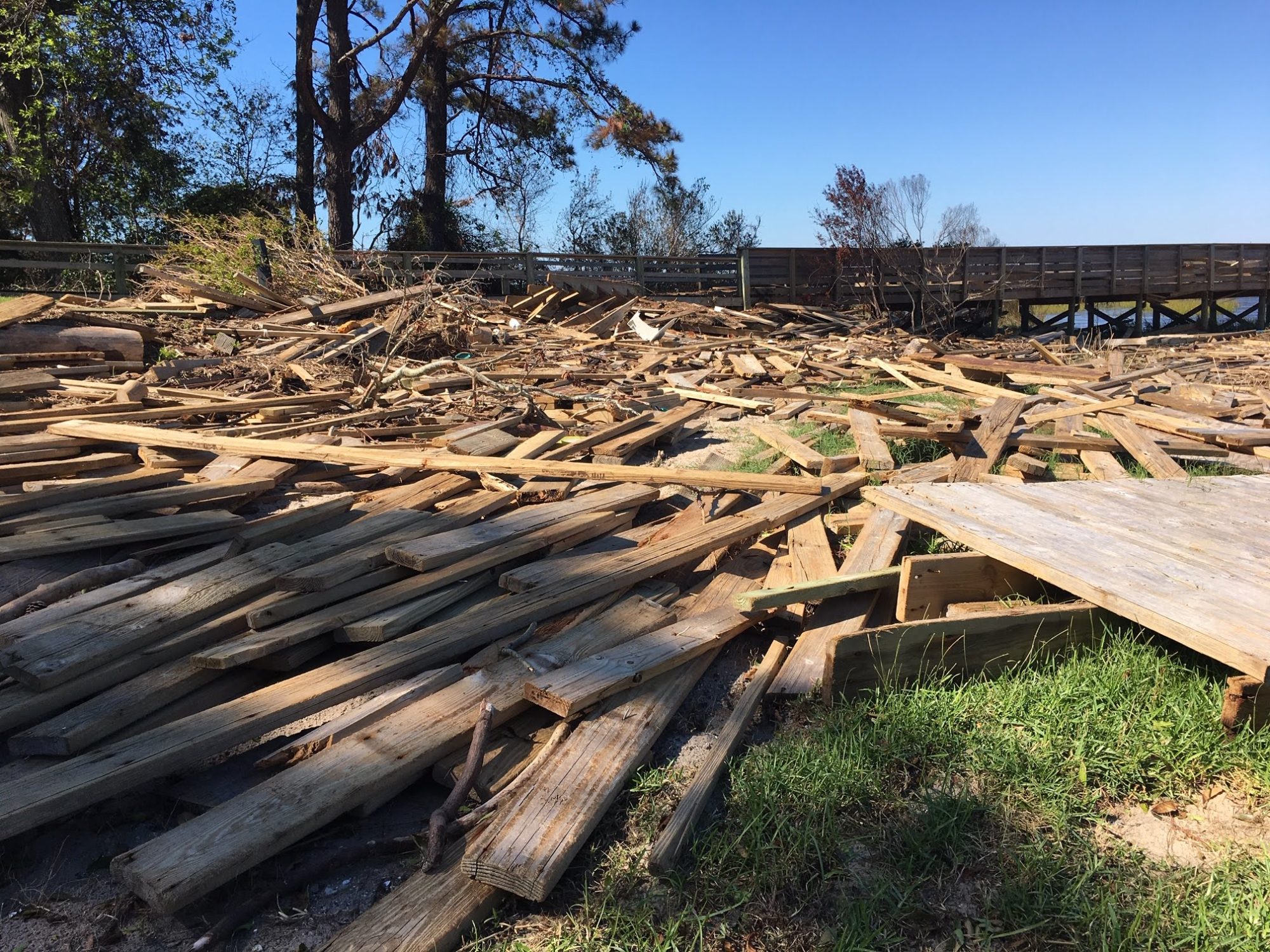
Tackle Trash
You can help clean up our coast—from hurricane debris to microplastics.

